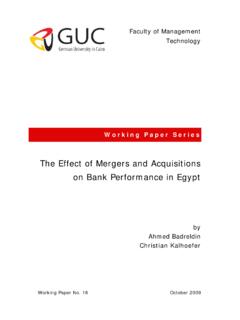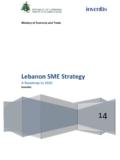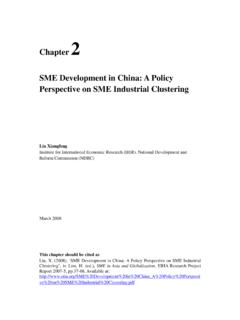Transcription of Financing Resources for Egyptian Small and Medium …
1 Working Paper No. 28 April 2011 Faculty of ManagementTechnology Working Paper Series Financing Resources for Egyptian Small and Medium Enterprises by Rola Nabil El Kabbani Christian Kalhoefer Rola Nabil El Kabbani Christian Kalhoefer German University in Cairo German University in Cairo Faculty of Management Technology Faculty of Management Technology Al Tagamoa Al Khames Al Tagamoa Al Khames 11835 New Cairo Egypt 11835 New Cairo Egypt (corresponding author) Financing Resources for Egyptian Small and Medium Enterprises by Rola Nabil El Kabbani Christian Kalhoefer April 2011 Abstract Even though Small and Medium enterprises (SMEs) represent the majority of the Egyptian firms, their value added is relatively low. According to pre-vious research, SMEs face a Financing gap that causes undercapitalization and represents an obstacle that hinders SMEs from growth.
2 This paper ana-lyzes the current situation of SMEs in Egypt and addresses the question whether the Financing problem still exists. In addition, we discuss the role of venture capital as a possible source of Financing . Based on data which has been gathered using questionnaires, it is investigated whether Egyptian SMEs do know and would accept venture capital Financing for their busi-nesses. Our results show that access to finance is still a significant bottle-neck for Egyptian SMEs. Venture capital Financing could help to close this Financing gap. JEL classification G24 Keywords SME, Financing Gap, Venture Capital 1 1 Introduction Small and Medium Enterprises (SMEs) in Egypt represent almost 90% of the enterprises and provide the main bulk of private sector employment, but their share in value-added is dispro-portional, as the share of manufacturing SMEs in net private manufacturing value-added is only about (Central Agency for Public Mobilization and Statistics 2001).
3 This implies that there are some factors that prevent them to reach their full potential. Around the world, SMEs face the same obstacles: either financial, especially the limited ac-cess to external funding, as well as non financial, related to knowhow, marketing, accounting and other business aspects of management. The limited access to external funding, which is mainly represented in debt especially bank loans is associated with the unattractiveness of SMEs from the creditor point of view. Bank loans require credit history, collaterals and pro-jections of future cash flows that typically are unavailable for SMEs (Beck and Demirguc-Kunt 2006: 2936 2939). Further sources are needed to satisfy the unmet demand of SMEs (Goodwin and Pinel 2001: 23). Besides debt, equity Financing could be considered as a source of Financing as well.
4 One form of equity Financing that is more oriented towards start up projects is represented through Venture Capital Corporations, a possible source of Financing that had been widely used and proved its success in both developed countries such as the US and Canada as well as develop-ing countries such as India (Christofidis and Debande 2001: 8). Therefore, this research focuses on the situation of Venture Capital Financing in Egypt. Based on primary data which has been gathered using questionnaires, this empirical paper has two main objectives: The first one is to shed the light on the main constraints faced cur-rently by Egyptian SMEs, and whether the access to finance still is an obstacle for Egyptian SMEs. It will also be examined if the Financing problem might differ from an industry to an-other, and if the size of the enterprise is a deterministic factor of accessing funds.
5 This step is necessary as the existing empirical data about Egypt is quite old. The second objective is to test whether Egyptian SMEs may accept using Venture Capital as equity Financing instru-ment and whether the acceptance is dependent on the main activity or size of the enterprise . In addition, it will be analyzed what may be the reason behind the hesitance or rejection of VC by SMEs. The organization of the paper is as follows: Chapter two discusses the theoretical background of Financing SME s, followed by a discussion of the research methodology in chapter three. 2 The empirical results and their interpretation are presented in chapter four.
6 Finally, chapter five summarizes the main results and provides some recommendations. 2 Theoretical Background SMEs are often classified by the number of employees and/or by the value of their assets. Classification by size varies within regions and across countries in relation to the size of the economy and its Resources (Culkin and Smith 2000: 148). The classification of Egyptian SMEs is dependant on both number of employees, capital used and sales turnover as seen in Table 1. Labor Fixed Assets, exclud-ing Land & Building in Sales in LE Manufacturing & Construction Small 5 - 49 5,000,000 10,000,000 Medium 50 99 10,000,000 20,000,000 Services and Trade Small 5 - 9 500,000 1,000,000 Medium 10 - 19 2,000,000 4,000,000 Table 1: Classification of Egyptian SME s (Source: FinBi-Finance and Banking Consultants International 2004: 40) The importance of the Small and Medium enterprise sector is reflected in the size of its con-tribution.
7 Based on the Central Agency for Public Mobilization and Statistics census of 1996, SME share of Private Sector Enterprises is of total number of establishments operating in the trade, service, manufacturing and construction sectors, which counts of 1,641,791 en-terprises, generating jobs for million workers, which contributes 75% of private sector non-agricultural employment. By 2006, the number of establishments had increased to million (representing an annual growth rate of about ). During these ten years, the pri-vate sector added approximately 70,000 new enterprises per year. Total employment in SMEs climbed from million to million in 2006, an increase of more than 60% since 1998 representing an average annual growth rate of (Central Agency for Public Mobilization and Statistics 2006).
8 Egyptian SMEs are concentrated in five governorates: Cairo, Giza, Dakahliya, Alexandria and Sharqiya, as almost half of the private sector is in these areas (Central Agency for Public Mobilization and Statistics 1996). They are predominantly concentrated in the trade sector, 3 due to the low entry barriers in terms of capital, skill and technology that are attributing this sector. The latest statistics regarding SMEs activities show that trade remains the primary economic activity, however, it lost part of its relative weight especially among the formal activities, where the percentage of SMEs dropped from 55% in 1998 to of all formal SMEs in 2006; however, it increased slightly in the case of informal SMEs from 38% to 41% in the same two years respectively (El Mahdi and Rashad 2006: 6-8).
9 Manufacturing activi-ties grew slightly from 19% in 1998 to of all SMEs in 2006. On the other hand, the combined service activities (Hotels, real estate, education, health etc.) lost a substantial part of 9% their relative weight, from 27% in 1998 to 18% in 2006. The continuous change in SMEs economic activities weights reflects SMEs ability to adapt to varying market condi-tions and needs (El Mahdi and Rashad 2006: 6-8). There is a very high degree of informality within Egyptian SMEs, even though the number of informal enterprises cannot be accurately depicted. There are two forms of establishments that may be found: enterprises that somehow can be estimated and street vendors, mobile units and home based enterprises which cannot.
10 The reason behind the high degree of infor-mality is due to the very high cost burden of going formal since it represents 40-60% of the total costs., Based on the last census in 2002, only 16% of establishments had acquired a commercial register ( Egyptian National Competitiveness Council 2007: 72). But on the other hand, the opportunity cost of staying informal is the limited opportunity to grow, as the in-formal businesses lose benefits such as applying for formal loans, and/or acquiring business development services and supply chain contracts, or any government support that might be available (Palmade 2005: 25). Generally, SMEs face obstacles that prevent them to perform and realize their unique contri-bution to the economy of Employment generation, Innovation, Poverty alleviation and Economic growth.










